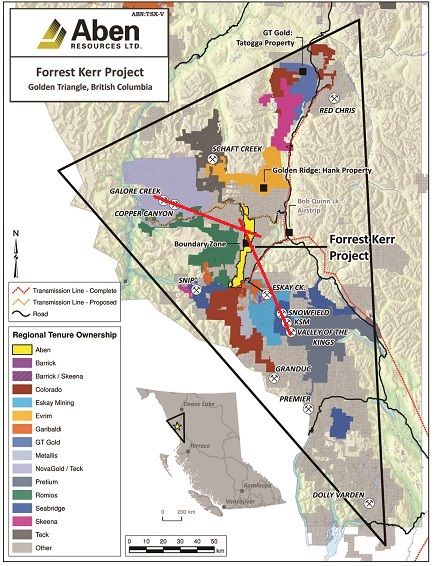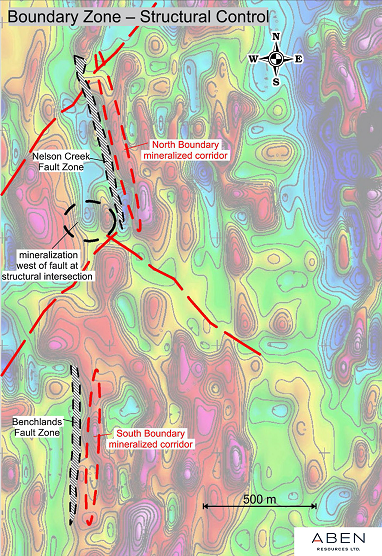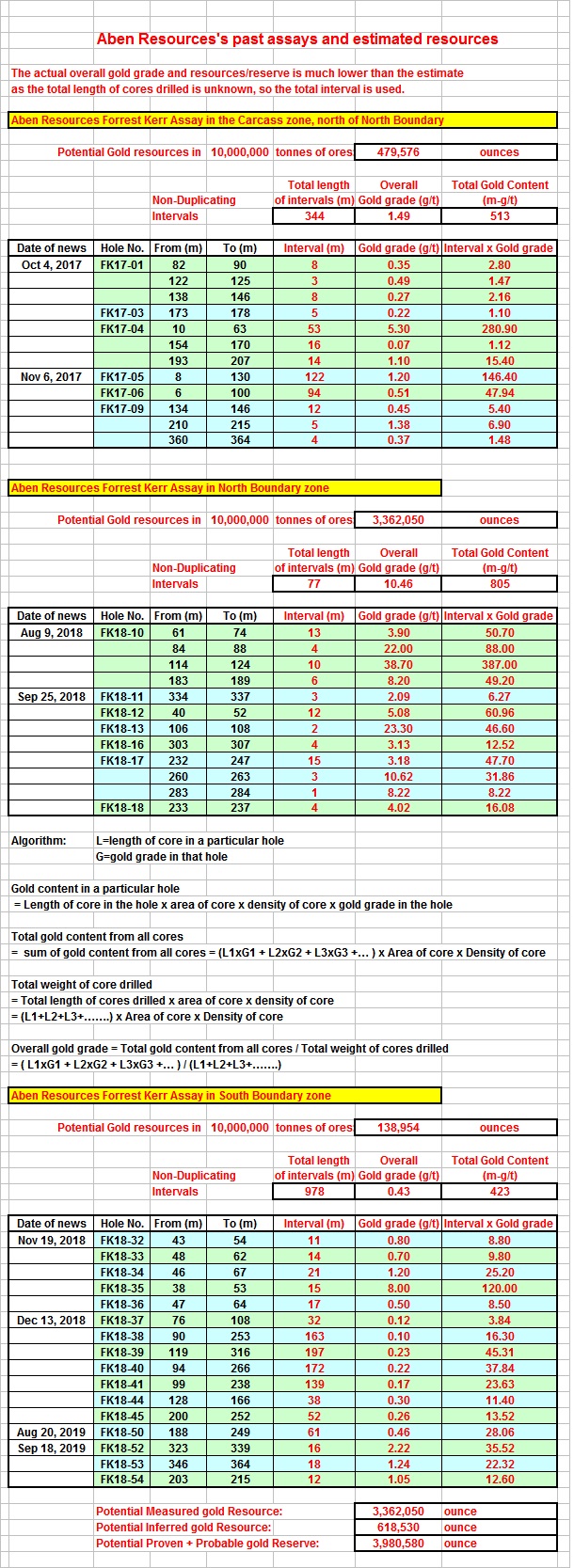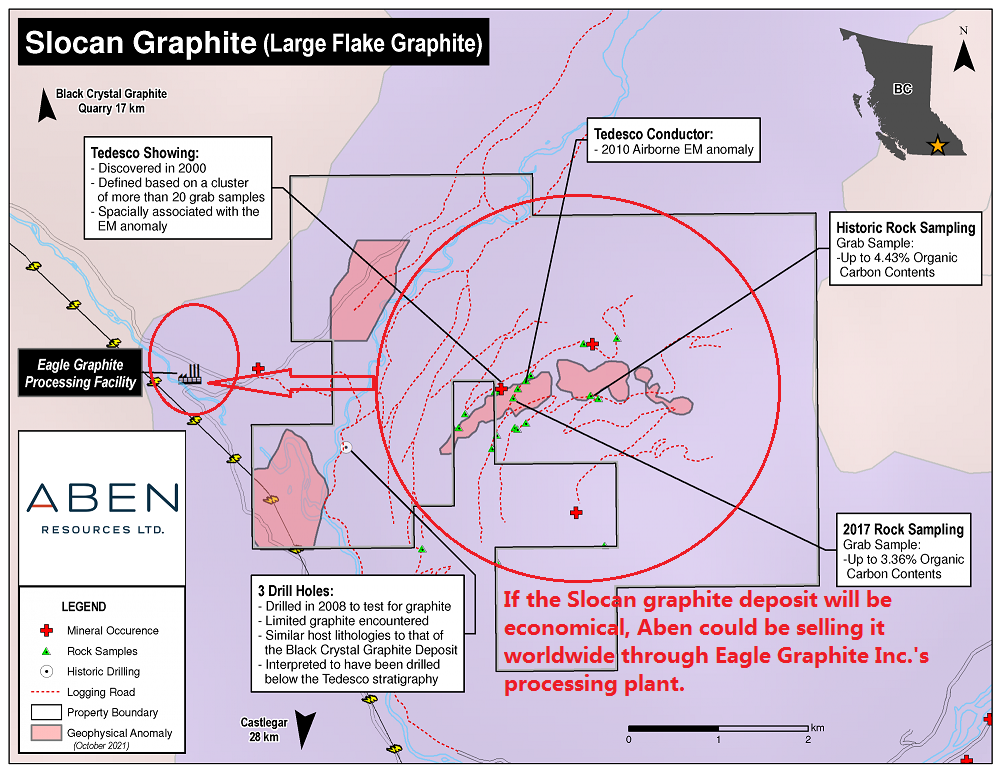(Total Views: 764)
Posted On: 02/07/2022 2:34:23 PM
Post# of 1088
Aben Resources's two hot irons in the fire ........................................
Forrest Kerr gold project
Forrest Kerr property is a huge area covering 23,397 hectares or 234 square Km (6.1 Km x 38.3 Km) while bonanza gold deposit occurs only in a small spot, so finding it is like looking for a pin in a haystack. But there is a greater chance of finding a gold mine along the 38 Km fault line that traverses the entire property in the north-south direction.
The Forrest Kerr in the Golden Triangle

https://investorshangout.com/images/MYImages/...tlines.jpg
The Boundary Zone

Assays from 3 different locations:

https://investorshangout.com/images/MYImages/...ources.jpg
In the 2018 drilling program only 7 holes were drilled in the North Boundary zone while most of the $7 million raised was spent drilling in the low gold grade South Boundary zone to test for more high grade mineralization. All of the 7 holes drilled in the North Boundary zone encountered medium long intervals of high grade gold, especially visible gold in Hole FK18-10 with assay of 38 g/t over 10 meters including 331 g/t over 1 meter, corroborated with Noranda's 1991 discovery of 326 g/t at 230 meters south of Hole FK18-10. Despite of the spectacular high gold grade assay, investors were disappointed with the low grade gold assay that followed and sold off the shares, but the assays in the news was so confusing that they did not know the low grade gold is from South Boundary zone, not from the North Boundary zone. When there are holes with 331 g/t and 326 g/t visible gold, there could be more as the geologists get closer to the source: A gold vein with numerous gold arteries that can run for hundreds of meters, Aben and Noranda had drilled into one or two of those gold arteries. But the geology in Forrest Kerr is very complicated, the geologists are studying and analyzing the data collected, only when they fully understand the intriguing geological structure will they set priority drilling targets.
Slocan Graphite project

https://investorshangout.com/images/MYImages/...roject.png
About Slocan Graphite Project
Graphite is a naturally occurring form of carbon and is an excellent conductor of both electricity and heat. It is becoming increasingly important as a critical strategic component in advancing alternative energy solutions including wind and solar power, hybrid vehicles and other alternative energy uses. It is also a mainstay of the steel production industry. Canada is currently ranked as the 5th largest supplier of graphite.
Graphite mineralization was initially discovered in logging road exposures in the late 1990’s. Ground and airborne geophysical surveys were completed in the project area in 2000 and 2010 respectively. Both surveys indicated strong conductive anomalies that correlate well with surface mineralization and are interpreted to extend along strike and down-dip of known occurrences. A limited number of documented samples have been taken across the Tedesco horizon and analysed for carbon graphite ranging from trace values to grades of up to 3.36 and 4.43 per cent.
Graphite mineralization is hosted primarily in carbonate and calc-silicate lithologies within the Passmore Dome of the Valhalla Metamorphic Complex, a geologic setting consistent with a crystalline flake graphite deposit model. Previous operators have estimated the mineralized horizon to be up to 50m thick, however cite that it is difficult to determine due to a lack of surface exposure. The horizon has never been tested by diamond drilling.
Past workers in the area concluded: “Although the graphite occurrences at Tedesco are in the early stages of exploration, geological, assay, and geophysical data indicate significant potential to form an economic deposit” (BC Assessment Report 26537). Eagle Plains geologists are of the opinion that the high-quality, large flake character of the graphite mineralization found to date, spatial extent of conductivity from a 2010 airborne electromagnetic (“EM”) survey, minimal historic exploration activity, excellent proximity to infrastructure and the favorable economic outlook for graphite as a strategic commodity make Slocan Graphite a compelling project for continued exploration and a potentially significant component of Eagle Plain’s broad and varied portfolio of exploration projects. The project is consistent with EPL’s policy of identifying and acquiring undervalued exploration projects during cyclical downturns within a particular commodity space.
The Slocan Graphite Project benefits from excellent infrastructure including a high-voltage transmission line within 1.2 km of the property boundaries, an extensive network of forestry roads on and around the property, and an existing graphite processing plant and facilities located 1.5 km west of the property, owned by Eagle Graphite Corporation. The processing plant has historically operated at a throughput rate of 20 tonnes of feed per hour, a rate roughly equivalent to an annual output of 4,000 tonnes of high carbon natural flake graphite. The facility is strategically located close to the US city of Spokane, Washington and the Canadian port of Vancouver, British Columbia, Eagle Graphite offers efficient and economical shipping of high grade material to destinations worldwide.
BC Government 2017 Geological Survey Assessment of Slocan Graphite
Scroll down to page 18, 19, 20 to see what minerals are found in that property
https://aris.empr.gov.bc.ca/ARISReports/37398.PDF
Graphite prices
https://www.northerngraphite.com/about-graphi...e-pricing/
Graphite market was valued at US$137.3 million in 2020 and is projected to reach $219.6 million by 2027 at a CAGR of 6.9%. Every million electric vehicle require around 75,000 tonnes of natural graphite. In 2020, spherical graphite demand in China alone was 240,000 tonnes, demand for graphite is forecasted increasing to 1.9 million tonnes by 2028.
Biden seeks to make half of new U.S. auto fleet electric by 2030
https://www.reuters.com/business/autos-transp...021-08-05/
The phenomena of high grade gold in every hole drilled in the North Boundary zone, visible gold near the fault line, close proximity to Eskay Creek and same geology as Eskay Creek all are indication that there is a gold mine in the North Boundary zone similar to that in Eskay Creek, but the geology in Forrest Kerr is just as complicated as that in Eskay Creek, since it took Stikine Resources 50 years to discover the bonanza gold deposit in Eskay Creek, certainly it will take more time for the Aben geologists to understand the intriguing geological structure in Forrest Kerr. Forrest Kerr is a huge area with 234 square kilometer while bonanza gold deposit occurs only in a small spot, so finding it is like looking for a pin in a haystack. The geologists are diligently analyzing the intriguing geological structure in Forrest Kerr, so no specific drilling targets have been set yet, thus the company will forego exploration in Forrest Kerr this year and concentrate on the Slocan Graphite project. If the graphite project will be commercially economical as the Eagle Graphite's geologists and local workers conferred that it will be, then at graphite price of minimum $1,000 per tonne and at annual production capacity of 4,000 tonnes, graphite production in Slocan Graphite can potentially generate $4 million annually, that will enhance shareholders value while sustaining the exploration in Forrest Kerr without the need for further financing, thus keeping the fully diluted share low to maximize future buyout value per share. Between now and 2024, if the geologists will set top priority drilling targets in Forrest Kerr, shareholders can be sure that the geologists have solved the intriguing geological puzzle in Forrest Kerr and have confidence in locating the source of high grade/visible gold. If they will drilling 27 g/t over 208 meters just as Stikine Resources did in Eskay Creek, then they will have drilled into a gold vein, then there will be a new gold mine in the Golden Triangle of BC, possibly Eskay Creek 2.0. Be reminded that Stikine Resources was sold to a major at $67 per share.
History of Eskay Creek mine, the world's massive high grade gold mine
In 1932 a prospector named Tom Mackay of Consolidated Stikine Resources was the first to recognize the area's unique geological setting after spotting an alluring rock outcrop from his single-engine bush plane. After staking the property he discovered a boulder broken free from its source higher up on the mountain, rolling several dozen meters downslope, assays from the boulder returned a spectacular five ounces of gold per tonne. Mackay explored the property for over 50 years but bonanza gold deposit was never found. In 1988 after investing in Consolidated Stikine Resources which held rights to Eskay Creek, geologist Ron Netolitzky became Stikine’s technical person and one of five controlling shareholders. He teamed up with Murray Pezim of Calpine Resources to raise $900,000 for a drill program and started exploring the area in the summer of 1990. After drilling 108 holes and with momentum building, they hit a fault. Chet Idziszek, Pezim’s geologist with a M.Sc. degree from McGill University observed gradually increasing gold grade and increasing interval length in the assays, he had an intuition that he must be very close to the main gold vein, he studied the maps and analysed the terrain then he ragged the drill rig to a spot 350 meters from the last hole drilled and drilled hole #109. Bingo, assays from hole 109 returned spectacular 27.2 g/t gold, 30.2 g/t silver over 208 meters (682 feet). In 1994 Eskay Creek went into production that lasted 14 years, finally ended in 2008. Eskay Creek had the highest grade gold on the planet and produced 3.3 million ounces of gold at a breathtaking 45 g/t Au, also 160 million ounces of silver at 2,224 g/t. Stikine Resources was acquired by Placer Dome and International Corona for $67 per share. Ron Netolitzky has had a very successful career in mining and mineral exploration with decades of experience and having been directly associated with three major mineral discoveries in Canada that have subsequently been put into production: Eskay Creek, Snip and Brewery Creek. Ron Netolitzky was inducted into the Canadian Mining Hall of Fame in 2014.
Forrest Kerr gold project
Forrest Kerr property is a huge area covering 23,397 hectares or 234 square Km (6.1 Km x 38.3 Km) while bonanza gold deposit occurs only in a small spot, so finding it is like looking for a pin in a haystack. But there is a greater chance of finding a gold mine along the 38 Km fault line that traverses the entire property in the north-south direction.
The Forrest Kerr in the Golden Triangle

https://investorshangout.com/images/MYImages/...tlines.jpg
The Boundary Zone

Assays from 3 different locations:

https://investorshangout.com/images/MYImages/...ources.jpg
In the 2018 drilling program only 7 holes were drilled in the North Boundary zone while most of the $7 million raised was spent drilling in the low gold grade South Boundary zone to test for more high grade mineralization. All of the 7 holes drilled in the North Boundary zone encountered medium long intervals of high grade gold, especially visible gold in Hole FK18-10 with assay of 38 g/t over 10 meters including 331 g/t over 1 meter, corroborated with Noranda's 1991 discovery of 326 g/t at 230 meters south of Hole FK18-10. Despite of the spectacular high gold grade assay, investors were disappointed with the low grade gold assay that followed and sold off the shares, but the assays in the news was so confusing that they did not know the low grade gold is from South Boundary zone, not from the North Boundary zone. When there are holes with 331 g/t and 326 g/t visible gold, there could be more as the geologists get closer to the source: A gold vein with numerous gold arteries that can run for hundreds of meters, Aben and Noranda had drilled into one or two of those gold arteries. But the geology in Forrest Kerr is very complicated, the geologists are studying and analyzing the data collected, only when they fully understand the intriguing geological structure will they set priority drilling targets.
Slocan Graphite project

https://investorshangout.com/images/MYImages/...roject.png
About Slocan Graphite Project
Graphite is a naturally occurring form of carbon and is an excellent conductor of both electricity and heat. It is becoming increasingly important as a critical strategic component in advancing alternative energy solutions including wind and solar power, hybrid vehicles and other alternative energy uses. It is also a mainstay of the steel production industry. Canada is currently ranked as the 5th largest supplier of graphite.
Graphite mineralization was initially discovered in logging road exposures in the late 1990’s. Ground and airborne geophysical surveys were completed in the project area in 2000 and 2010 respectively. Both surveys indicated strong conductive anomalies that correlate well with surface mineralization and are interpreted to extend along strike and down-dip of known occurrences. A limited number of documented samples have been taken across the Tedesco horizon and analysed for carbon graphite ranging from trace values to grades of up to 3.36 and 4.43 per cent.
Graphite mineralization is hosted primarily in carbonate and calc-silicate lithologies within the Passmore Dome of the Valhalla Metamorphic Complex, a geologic setting consistent with a crystalline flake graphite deposit model. Previous operators have estimated the mineralized horizon to be up to 50m thick, however cite that it is difficult to determine due to a lack of surface exposure. The horizon has never been tested by diamond drilling.
Past workers in the area concluded: “Although the graphite occurrences at Tedesco are in the early stages of exploration, geological, assay, and geophysical data indicate significant potential to form an economic deposit” (BC Assessment Report 26537). Eagle Plains geologists are of the opinion that the high-quality, large flake character of the graphite mineralization found to date, spatial extent of conductivity from a 2010 airborne electromagnetic (“EM”) survey, minimal historic exploration activity, excellent proximity to infrastructure and the favorable economic outlook for graphite as a strategic commodity make Slocan Graphite a compelling project for continued exploration and a potentially significant component of Eagle Plain’s broad and varied portfolio of exploration projects. The project is consistent with EPL’s policy of identifying and acquiring undervalued exploration projects during cyclical downturns within a particular commodity space.
The Slocan Graphite Project benefits from excellent infrastructure including a high-voltage transmission line within 1.2 km of the property boundaries, an extensive network of forestry roads on and around the property, and an existing graphite processing plant and facilities located 1.5 km west of the property, owned by Eagle Graphite Corporation. The processing plant has historically operated at a throughput rate of 20 tonnes of feed per hour, a rate roughly equivalent to an annual output of 4,000 tonnes of high carbon natural flake graphite. The facility is strategically located close to the US city of Spokane, Washington and the Canadian port of Vancouver, British Columbia, Eagle Graphite offers efficient and economical shipping of high grade material to destinations worldwide.
BC Government 2017 Geological Survey Assessment of Slocan Graphite
Scroll down to page 18, 19, 20 to see what minerals are found in that property
https://aris.empr.gov.bc.ca/ARISReports/37398.PDF
Graphite prices
https://www.northerngraphite.com/about-graphi...e-pricing/
Graphite market was valued at US$137.3 million in 2020 and is projected to reach $219.6 million by 2027 at a CAGR of 6.9%. Every million electric vehicle require around 75,000 tonnes of natural graphite. In 2020, spherical graphite demand in China alone was 240,000 tonnes, demand for graphite is forecasted increasing to 1.9 million tonnes by 2028.
Biden seeks to make half of new U.S. auto fleet electric by 2030
https://www.reuters.com/business/autos-transp...021-08-05/
The phenomena of high grade gold in every hole drilled in the North Boundary zone, visible gold near the fault line, close proximity to Eskay Creek and same geology as Eskay Creek all are indication that there is a gold mine in the North Boundary zone similar to that in Eskay Creek, but the geology in Forrest Kerr is just as complicated as that in Eskay Creek, since it took Stikine Resources 50 years to discover the bonanza gold deposit in Eskay Creek, certainly it will take more time for the Aben geologists to understand the intriguing geological structure in Forrest Kerr. Forrest Kerr is a huge area with 234 square kilometer while bonanza gold deposit occurs only in a small spot, so finding it is like looking for a pin in a haystack. The geologists are diligently analyzing the intriguing geological structure in Forrest Kerr, so no specific drilling targets have been set yet, thus the company will forego exploration in Forrest Kerr this year and concentrate on the Slocan Graphite project. If the graphite project will be commercially economical as the Eagle Graphite's geologists and local workers conferred that it will be, then at graphite price of minimum $1,000 per tonne and at annual production capacity of 4,000 tonnes, graphite production in Slocan Graphite can potentially generate $4 million annually, that will enhance shareholders value while sustaining the exploration in Forrest Kerr without the need for further financing, thus keeping the fully diluted share low to maximize future buyout value per share. Between now and 2024, if the geologists will set top priority drilling targets in Forrest Kerr, shareholders can be sure that the geologists have solved the intriguing geological puzzle in Forrest Kerr and have confidence in locating the source of high grade/visible gold. If they will drilling 27 g/t over 208 meters just as Stikine Resources did in Eskay Creek, then they will have drilled into a gold vein, then there will be a new gold mine in the Golden Triangle of BC, possibly Eskay Creek 2.0. Be reminded that Stikine Resources was sold to a major at $67 per share.
History of Eskay Creek mine, the world's massive high grade gold mine
In 1932 a prospector named Tom Mackay of Consolidated Stikine Resources was the first to recognize the area's unique geological setting after spotting an alluring rock outcrop from his single-engine bush plane. After staking the property he discovered a boulder broken free from its source higher up on the mountain, rolling several dozen meters downslope, assays from the boulder returned a spectacular five ounces of gold per tonne. Mackay explored the property for over 50 years but bonanza gold deposit was never found. In 1988 after investing in Consolidated Stikine Resources which held rights to Eskay Creek, geologist Ron Netolitzky became Stikine’s technical person and one of five controlling shareholders. He teamed up with Murray Pezim of Calpine Resources to raise $900,000 for a drill program and started exploring the area in the summer of 1990. After drilling 108 holes and with momentum building, they hit a fault. Chet Idziszek, Pezim’s geologist with a M.Sc. degree from McGill University observed gradually increasing gold grade and increasing interval length in the assays, he had an intuition that he must be very close to the main gold vein, he studied the maps and analysed the terrain then he ragged the drill rig to a spot 350 meters from the last hole drilled and drilled hole #109. Bingo, assays from hole 109 returned spectacular 27.2 g/t gold, 30.2 g/t silver over 208 meters (682 feet). In 1994 Eskay Creek went into production that lasted 14 years, finally ended in 2008. Eskay Creek had the highest grade gold on the planet and produced 3.3 million ounces of gold at a breathtaking 45 g/t Au, also 160 million ounces of silver at 2,224 g/t. Stikine Resources was acquired by Placer Dome and International Corona for $67 per share. Ron Netolitzky has had a very successful career in mining and mineral exploration with decades of experience and having been directly associated with three major mineral discoveries in Canada that have subsequently been put into production: Eskay Creek, Snip and Brewery Creek. Ron Netolitzky was inducted into the Canadian Mining Hall of Fame in 2014.
